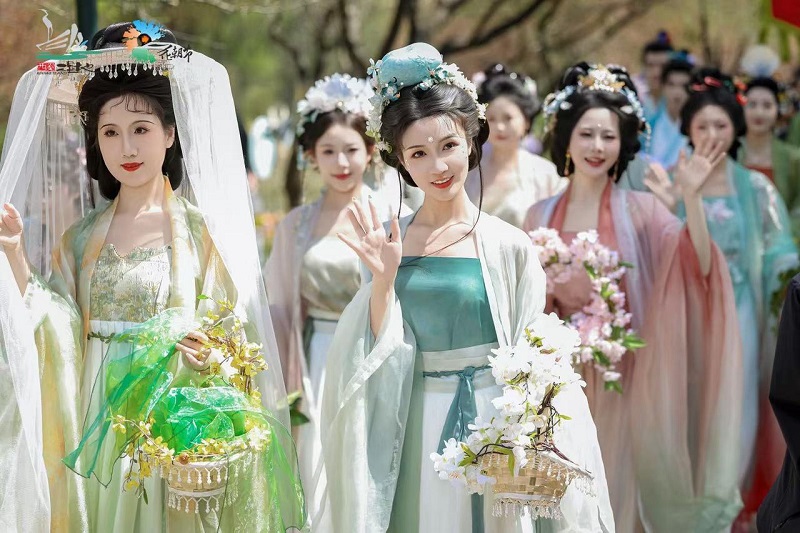Pavilion stands as testament to ties

CHINA DAILY
Chinese-style structure inspired by ancient tale and built for garden competition offers reminder of the power of love, Xing Yi reports.
Some 40 kilometers southwest of central London lies a garden. About five minutes' walk inside that garden — the Royal Horticultural Society's Garden Wisley, in Surrey — is a small lake. And, on the bank of that lake stands a Chinese-style building called Butterfly Lovers Pavilion.
The wooden hexagonal pavilion has attracted hundreds of thousands of visitors each year since it was built in 2005.
Recently, a restoration project has ensured the beloved pavilion can continue to be a symbol of cultural exchanges between China and the United Kingdom.
The traditional structure was originally featured in a Chinese show-garden at the Hampton Court Flower Show, one of the world's biggest gardening contests and festivals, in 2005.
After 17 years, the pavilion's designer, Liu Tingfeng, a professor of landscape and garden design at Tianjin University, still vividly recalls the day the show-garden was unveiled.
"The British visitors were amazed by the pavilion and Chinese garden, because our philosophies in terms of making a garden are different — we had very few f lowers, but visitors could f ind various views and different mini-landscapes as they stepped inside and looked from different angles," Liu said, adding that there was a lot of enthusiasm and media coverage at the time.
With a height of 6 meters and a base width of 5 meters, the six sides of the pavilion are decorated with butterfly patterns, in homage to the Chinese legend of Liang Shanbo and Zhu Yingtai, or the Butterfly Lovers.
Their story is set during ancient China's Eastern Jin Dynasty (317-420 AD), with Zhu, a daughter in a wealthy family, entering an all-male academy disguised as a boy, where she falls in love with her classmate, Liang.The lovers are unable to marry because of objections from Zhu's families, and both die prematurely, turning as they do into beautiful butterflies that fly of together into an eternal paradise.
The story has been told from generation to generation in China, and taken as the inspiration for bountiful artworks that, in turn, have had profound effects on Chinese culture and, in this case, a pavilion.
The building of the pavilion was sponsored by Hangzhou Blue-Sky Landscape Group, from Zhejiang province, where the Butterfly Lovers story was set. All materials used in its construction were shipped to the UK, and put together, piece by piece, to be the focal point of the temporary Chinese garden at the f lower show in 2005, which won a sliver-gilt award.
When the show was over, Liu and the company decided to leave the pavilion in the UK, as a legacy. Liu chose Garden Wisley as the pavilion's final home after the Royal Horticultural Society, or RHS, offered several possible locations.
"I chose the location because it is beside a lake, because in Chinese philosophy, we always try to create shan shui, or mountains and waters, in the garden," Liu said.
Mathew Pottage, curator of the garden, said: "It quickly became very popular with our visitors. People asked if they could propose to their partner in the pavilion. People asked if they could have a drink reception there.
"We really loved the pavilion, as we have many Chinese plants here in the garden and the pavilion is very well positioned."
Pottage said the pavilion's pillars were made of Chinese native dawn redwood, a tree of which there are two living examples close to the pavilion.
As time passed, parts of the pavilion started to deteriorate and the garden's managers eventually had to set up a perimeter around it, to ensure there were no accidents.
In a short documentary about the signature f lowers of China, produced by the TV program China Hour in 2021, Pottage talked about the poor condition of the pavilion and asked for assistance from the local Chinese community.
When the news reached the Chinese Chamber of Commerce in the UK, or CCCUK, it started to fundraise for the pavilion's restoration, as part of its charity work within the Lord Mayor's Appeal, the official charity of the City of London.
Zhang Huijuan, vice-chair of the CCCUK, said the pavilion had become a symbol of China-UK friendship, and with donations from the chamber's member companies, including the Bank of China, ICBC UK, and Haier, a six-month restoration project was launched.
Pottage explained the principle of the project: "We want it to look loved and maintained, but don't want it to look sparkling new. British winter is very wet and it rains a lot. So, there is always a balance between trying to keep the wood sound and keeping it looking natural."
The restoration was completed by the end of 2022, and the CCCUK and the RHS held a celebration in front of the pavilion in April.
At the event, Zhang said: "The pavilion has been restored to its original splendor, displaying unique Chinese charm and symbolizing the continued cultural exchanges between China and the UK … In the future, CCCUK will encourage more members to contribute to public charity and social welfare to promote cultural and economic cooperation between China and the UK."
Caroline Wright, CEO of the Lord Mayor's Appeal, attended the ceremony and spoke about the charity projects the appeal had engaged in with the CCCUK in the past, including the building of a multimedia classroom for a rural students in Shanxi province, and construction of a clinic in Yunnan province.
Zhao Fei, minister of China's embassy in the UK, also attended the celebration and told attendees about the Chinese story at the heart of the pavilion.
"The story is known as Romeo and Juliet in the East," Zhao said: "This ending vividly portrays the pursuit of harmony between human nature and the pursuit of perfection by the Chinese people."
Heniretta Rous, one of the guests at the event, said she did not appreciate the significance of the pavilion and the story that inspired it before she attended.
"But now, having known the story, I've got quite involved and I'm very touched by the feeling that's gone into this pavilion," she said.
During the ceremony, Chinese opera singer Wang Beibei and two Italian musicians, Andrea Granitzio and Giovanni Pasini, performed an excerpt from an opera inspired by the story of the Butterfly Lovers.
Clare Matterson, director-general of the RHS, said the pavilion had become a much-loved landmark at Garden Wisley, and, as Chinese horticulture and design have had such an influence around the world, the RHS was delighted the pavilion had been restored.
"With all of my heart, it is a huge thank you to the Chinese Chamber of Commerce in the UK and everybody here for the support in helping us to secure its future, the future of a beautiful celebration of Chinese culture and tradition in the very heart of our garden," she said.
Learning about the restoration of the pavilion, Liu, its designer, who was in Tianjin and could not attend the reopening, said: "I feel so proud that the Chinese pavilion still stands there, representing a mix of Chinese and British gardening culture.
"The lovely British summer will soon come, and butterf lies will f lutter in the garden again."
-
Xixi Wetland invites visitors to Huazhao Festival
March 25, 2025
-
Hangzhou sets standard for concert hosting
March 19, 2025
-
What is making Hangzhou the new tech powerhouse of China?
March 10, 2025
-
Inside Hangzhou: China's high-tech dream factory
March 12, 2025



